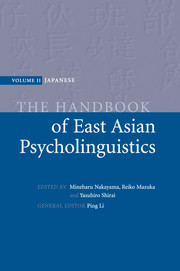Book contents
- Frontmatter
- Contents
- List of figures
- List of contributors
- In memory of Miwa Nishimura
- Preface
- Introduction
- Language acquisition
- Part II Language processing
- 26 The phonetic and phonological organization of speech in Japanese
- 27 Speech segmentation by Japanese listeners: its language-specificity and language-universality
- 28 Prosody in sentence processing
- 29 Speech errors
- 30 Effects of word properties on Japanese sentence processing
- 31 Orthographic processing
- 32 Lexical access
- 33 Incrementality in Japanese sentence processing
- 34 Processing alternative word orders in Japanese
- 35 Processing relative clauses in Japanese: coping with multiple ambiguities
- 36 Processing empty categories in Japanese
- 37 The difficulty of certain sentence constructions in comprehension
- 38 Reading and working memory
- 39 Sentence production in Japanese
- 40 The neural basis of syntactic processing in Japanese
- 41 The competition model
- 42 Connectionist models
- 43 Computational linguistics
- 44 Language and gesture as a single communicative system
- References
- Name index
- Subject index
35 - Processing relative clauses in Japanese: coping with multiple ambiguities
from Part II - Language processing
Published online by Cambridge University Press: 05 June 2012
- Frontmatter
- Contents
- List of figures
- List of contributors
- In memory of Miwa Nishimura
- Preface
- Introduction
- Language acquisition
- Part II Language processing
- 26 The phonetic and phonological organization of speech in Japanese
- 27 Speech segmentation by Japanese listeners: its language-specificity and language-universality
- 28 Prosody in sentence processing
- 29 Speech errors
- 30 Effects of word properties on Japanese sentence processing
- 31 Orthographic processing
- 32 Lexical access
- 33 Incrementality in Japanese sentence processing
- 34 Processing alternative word orders in Japanese
- 35 Processing relative clauses in Japanese: coping with multiple ambiguities
- 36 Processing empty categories in Japanese
- 37 The difficulty of certain sentence constructions in comprehension
- 38 Reading and working memory
- 39 Sentence production in Japanese
- 40 The neural basis of syntactic processing in Japanese
- 41 The competition model
- 42 Connectionist models
- 43 Computational linguistics
- 44 Language and gesture as a single communicative system
- References
- Name index
- Subject index
Summary
Introduction
It has been frequently noted that head-final languages such as Japanese are a challenge for a left-to-right parser, in which information provided by the verb plays a very important role. Among other constructions, relative clauses in Japanese in particular pose a tough challenge because they potentially involve multiple kinds of temporary/global ambiguities at different stages of parsing. In order to correctly interpret a Japanese relative clause, the parser needs to know, first of all, that it is a relative clause construction, which isn't evident in the early stages of the left–right parsing. It is also necessary to determine at which point of the sentence the clause starts, and what grammatical and/or thematic role the head noun is associated with within the relative clause. Furthermore, there can also be ambiguity as to the identity of the head noun, when the first NP in the relative head position is a complex NP, which is part of an larger NP.
These problems come from the syntactic and morphological properties of the language that fail to provide sufficient information about the correct structure for the input; including head finality, word order, and availability of empty arguments, as well as the lack of overt relative pronouns. In what follows, I will relate these syntactic facts with the emergence of various kinds of temporary/global ambiguities that occur at multiple levels of syntactic parsing.
- Type
- Chapter
- Information
- The Handbook of East Asian Psycholinguistics , pp. 264 - 269Publisher: Cambridge University PressPrint publication year: 2006
- 3
- Cited by



